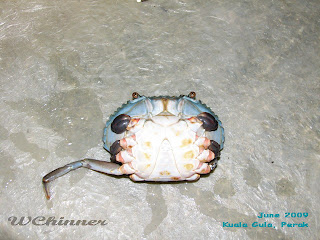Tourists visiting Langkawi were told that their visit will not be complete without having experienced the island's magical mangroves. Very true.
When a tourist arrives at Langkawi airport or jetty, the tourist will be handed with flyers after flyers for things to do on the island. Pick up any one of those flyers and these words will be staring at your face. "Mangroves Cruise"; "Mangroves Safari";"River Cruise";"Fish Farm";"Bat Cave";"Crocodile Cave" and the worst "Eagle Feeding". With such heavy promotions and raving about the mangroves, tourists would definitely be looking forward to partake in it. Tourists can pick a boat from the Kilim or Tanjung Rhu jetty and will be enthralled by a two or three hour ride even without a guide onboard.
When a tourist arrives at Langkawi airport or jetty, the tourist will be handed with flyers after flyers for things to do on the island. Pick up any one of those flyers and these words will be staring at your face. "Mangroves Cruise"; "Mangroves Safari";"River Cruise";"Fish Farm";"Bat Cave";"Crocodile Cave" and the worst "Eagle Feeding". With such heavy promotions and raving about the mangroves, tourists would definitely be looking forward to partake in it. Tourists can pick a boat from the Kilim or Tanjung Rhu jetty and will be enthralled by a two or three hour ride even without a guide onboard.
Langkawi was bestowed with the land and sea forests surrounded by prehistoric fossils and rock formations since some millions of years ago. Her mangroves were groomed well with the amazing karstic features of Setul formation that formed about 45o million years ago. Having such blessed natural heritage, Langkawi has became popular among the tourists that love to spend their holiday relaxing in the serenity of nature. The result of the high influx of tourists to the island has created many lucrative job opportunities for the locals. Over the years, many of the locals that were into fisheries and agriculture had embarked into tourism related jobs such as taxi, bus drivers, restaurant and boat operators. Then gradually, Langkawi has gained a higher status to become a UNESCO heritage site in mid 2007 and is now known as Langkawi Geopark.
With the Geopark status, the amount of tourists coming in has doubled or if not, almost tripled. This benefits the island with such huge economic boom and yet I am witnessing the sufferings of Langkawi's flora and fauna that they have to bear daily.
Great supply of tourists resulted in mushrooming of operators particularly for the mangroves. The latest craze was the 1km traffic congestion at Kilim jetty due to tourists waiting for availability of boats to take them out. Welcome to the school holidays and festive season!
While there were lots of tourists waiting to go for the mangroves tour, boat skippers were often instructed to cover a route with various stopovers very quickly and to return to jetty for the next tourists pickup. As such, these boats will speed like F1 drivers in the mangroves so they can make as many trips as they can for a day. More trips=more $$$.
No doubt that mangroves are able to adapt in the soft unstable soil. However, constant slamming of waves created by the speeding boats will accelerate the action of mud to be washed off from the banks causing sediments run-off. The consequences will be erosion that had caused some of the trees to collapse. Sediments run-off can pose hazard to the health of the coral reefs that reside along the coastal areas. Mud carried out to the sea by the current will eventually be settled onto the reefs, shading the reefs from sunlight and eventually killing them.
Speeding boats not only pose hazards to the mangroves forest but also to other users of the mangroves such as the slower boats and kayaks. There were incidents whereby speeding boats turning into the sharp corners had collided with other boats. Luckily there were no mishaps.
There was another incident whereby a boat was almost tipped over by big waves caused by an overloaded twin-engine boat that was speeding like Michael Schumacher. Because these operators are now so used to speeding in the mangroves, this habit had been formed and is hard to die. They even speed during the low tourists season.
This is what I find difficult for me to understand about locals here. Tourists make their way to Langkawi because of what the island can offer best. Langkawi will never be a destination for shopping even though it is a duty free island because people come here for nature. If these operators are allowed to continuously behave like "Mat Rempit" in the mangroves, all I can say is that these locals are breaking their own rice bowls. Check out what Mat Rempit means.
The good news is that there are also responsible companies offering passionate nature guides that conduct nature excursions in an ethical manner. You will expect to pay more for these excursions, however, the investment you make will return you with educational and informative experiences and not just fun boat joy rides. Example of a company will be
This is the first part of this topic of my blog. Coming next will be my viewpoints on eagle feeding, wildlife feeding and what influences tourists have over ecotourism.
... Read full post ...

























































